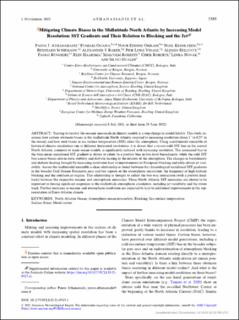Mitigating climate biases in the midlatitude North Atlantic by increasing model resolution: SST gradients and their relation to blocking and the jet
Athanasiadis, Panos J.; Ogawa, Fumiaki; Omrani, Nour-Eddine; Keenlyside, Noel Sebastian; Schiemann, Reinhard; Baker, Alexander J.; Vidale, Pier Luigi; Bellucci, Alessio; Ruggieri, Paolo; Haarsma, Rein; Roberts, Malcolm J.; Roberts, Chris; Novak, Lenka; Gualdi, Silvio
Journal article, Peer reviewed
Published version

Åpne
Permanent lenke
https://hdl.handle.net/11250/3039943Utgivelsesdato
2022Metadata
Vis full innførselSamlinger
- Geophysical Institute [1198]
- Registrations from Cristin [9791]
Sammendrag
Starting to resolve the oceanic mesoscale in climate models is a step change in model fidelity. This study examines how certain obstinate biases in the midlatitude North Atlantic respond to increasing resolution (from 1° to 0.25° in the ocean) and how such biases in sea surface temperature (SST) affect the atmosphere. Using a multimodel ensemble of historical climate simulations run at different horizontal resolutions, it is shown that a severe cold SST bias in the central North Atlantic, common to many ocean models, is significantly reduced with increasing resolution. The associated bias in the time-mean meridional SST gradient is shown to relate to a positive bias in low-level baroclinicity, while the cold SST bias causes biases also in static stability and diabatic heating in the interior of the atmosphere. The changes in baroclinicity and diabatic heating brought by increasing resolution lead to improvements in European blocking and eddy-driven jet variability. Across the multimodel ensemble a clear relationship is found between the climatological meridional SST gradients in the broader Gulf Stream Extension area and two aspects of the atmospheric circulation: the frequency of high-latitude blocking and the southern-jet regime. This relationship is thought to reflect the two-way interaction (with a positive feedback) between the respective oceanic and atmospheric anomalies. These North Atlantic SST anomalies are shown to be important in forcing significant responses in the midlatitude atmospheric circulation, including jet variability and the storm track. Further increases in oceanic and atmospheric resolution are expected to lead to additional improvements in the representation of Euro-Atlantic climate.